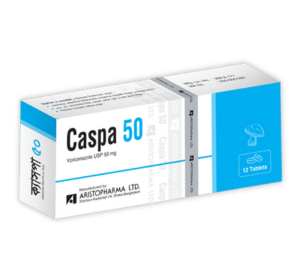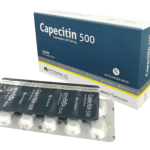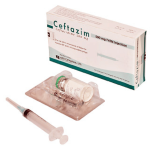Caspa (Voriconazole)

Therapeutic Group : Antifungal
Presentation:
Caspa 50 Tablet: Each film coated tablet contains Voriconazole USP 50 mg.
Caspa 200 Tablet: Each film coated tablet contains Voriconazole USP 200 mg.
Pharmacology:
Voriconazole is an azole antifungal drug. It inhibits the fungal cytochrome P-450 mediated 14 alpha-lanosterol demethylation, an essential step in fungal ergosterol biosynthesis. The accumulation of 14 alpha-methyl sterols correlate with the subsequent loss of ergosterol in the fungal cell wall and may be responsible for the antifungal activity of voriconazole.
Indications:
Caspa is indicated for the treatment of adults and pediatric patients 2 years of age and older with:
* Invasive aspergillosis
* Candidemia in non-neutropenics and other deep tissue Candida infections
* Esophageal candidiasis
* Serious fungal infections caused by Scedosporium apiospermum and Fusarium species including Fusarium solani, in patients intolerant of, or refractory to, other therapy.
Dosage & Administration:
Caspa tablets or oral suspension to be taken at least one hour before or after a meal.
Dosage in adults
| Infection | Dose | |
|---|---|---|
| Loading (Day-1) | Maintenance (From Day-2) | |
| Invasive Aspergillosis | 400 mg every 12 hours | 200 mg every 12 hours for 11 weeks |
| Serious Fungal infections like Scedosporiosis and Fusariosis | ||
| Candidemia (non-neutropenic) and other deep tissue Candida infections | 200 mg every 12 hours for at least 14 days after resolution of symptoms | |
| Esophageal Candidiasis | 200 mg every 12 hours for a minimum 14 days and for at least7 days after the resolution of sign & symptoms | |
* Patients who weigh less than 40 kg should receive half of the adult dose
Dosage in children 2 years of age and older
| Infection | Dose | |
|---|---|---|
| Loading (Day-1) | Maintenance (From Day-2) | |
| Invasive Aspergillosis | 9 mg/kg every 12 hours | 9 mg/kg every 12 hours for6 weeks to 12 weeks |
| Serious Fungal infections like Scedosporiosis and Fusariosis | ||
| Candidemia (non-neutropenic) and other deep tissue Candida infections | 9 mg/kg every 12 hours for at least 14days after resolution of symptoms | |
| Esophageal Candidiasis | 9 mg/kg every 12 hours for a minimum 14 days and for at least 7 days after the resolution of sign & symptoms (maximum 42 days) | |
* Children aged above 12 years weighing > 50 kg should use adult dosage.
Contrainidications:
- Hypersensitivity to voriconazole or its excipients.
- Coadministration with cisapride, pimozide or quinidine, sirolimus due to risk of serious adverse reactions.
- Coadministration with rifampin, carbamazepine, long-acting barbiturates, efavirenz, ritonavir, rifabutin, ergot alkaloids and St. John’s Wort due to risk of loss of efficacy
Warning & Precautions:
- Hepatic Toxicity: Serious hepatic reactions reported. Evaluate liver function tests at start of and during Voriconazole therapy.
- Arrhythmias and QT Prolongation: Correct potassium, magnesium and calcium prior to use; caution patients with proarrhythmic conditions.
- Visual Disturbances (including optic neuritis and papilledema): Monitor visual function if treatment continues beyond 28 days.
- Photosensitivity: Avoid sunlight due to risk of photosensitivity.
- Patients with Hereditary Galactose Intolerance, Lapp Lactase Deficiency or Glucose-Galactose
Malabsorption: Voriconazole tablets should not be given to these patients because it contains lactose.
Side effects:
The most common side effects may include visual disturbances, fever, nausea, rash, vomiting, chills, headache, liver function test abnormal, tachycardia, hallucinations, pyrexia, epistaxis, abdominal pain, diarrhea, hypokalemia, cough, thrombocytopenia, peripheral edema, hyperglycemia, dyspnea, hypocalcemia, hypophosphatemia, LFT abnormal, mucosal inflammation, photophobia, abdominal distention, constipation, dizziness, hemoptysis, hypoalbuminemia, hypomagnesemia, renal impairment, upper respiratory tract infection etc.
Drug interaction:
- CYP3A4, CYP2C9, and CYP2C19 inhibitors and inducers: Adjust voriconazole dosage and monitor for adverse reactions or lack of efficacy.
- Voriconazole may increase the concentrations and activity of drugs that are CYP3A4, CYP2C9 and CYP2C19 substrates. Reduce dosage of these other drugs and monitor for adverse reactions.
- Phenytoin or Efavirenz: with co-administration, increase maintenance oral and intravenous dosage of voriconazole.
OVERDOSE
Pediatric patients who received up to five times the recommended dose of voriconazole, a single adverse event of photophobia of 10 minutes duration was reported. There is no known antidote to voriconazole. Voriconazole is hemodialyzed with clearance of 121 mL/min may assist in the removal of voriconazole from the body.
Use in special groups:
- Pregnancy: Voriconazole can cause fetal harm when administered to a pregnant woman. There are no available data on the use of Voriconazole in pregnant women.
- Lactation: No data are available regarding the presence of Voriconazole in human milk, the effects of Voriconazole on the breastfed infant, or the effects on milk production.
- Pediatrics: Safety and effectiveness in patients younger than 2 years has not been established.
- Geriatric Use: Overall safety profile of the elderly patients is similar to that of the young so no dosage adjustment is recommended.
- Hepatic Impairment: Use half the maintenance dose in adult patients with mild to moderate hepatic impairment (Child-Pugh Class A and B).
- Renal Impairment: No dose adjustment is necessary for oral dosing in patients with mild to severe renal impairment.
Storage:
Store below 30°C in a dry place and protect from light. Keep out of the reach of children.
Packing:
Caspa 50 Tablet: Each box contains 12’s tablets in alu-alu blister pack.
Caspa 200 Tablet: Each box contains 10’s tablets in alu-alu blister pack.



